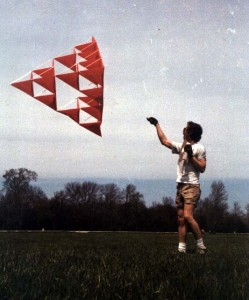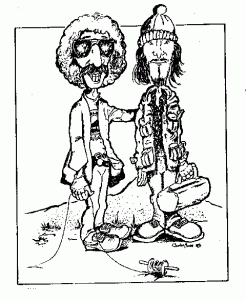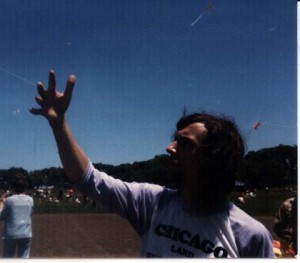Had a really great time with responses from many of you on Chapter One of Tangents and Trivia. I really had not realized how many people claim to have had me as their “Charlie Moore”. This is very gratifying to learn. I have always believed that it is important to share what you enjoy. That’s what Charlie Moore did for me and I am happy to be able to do it for others. That is really what Tangents and Trivia is all about, sharing what I have learned in the wonderful and exciting world of kiting.
I received a great e-mail from Jeff Greenwald of Wyoming. He was also introduced to kiteflying with the help of a sled kite. Jeff has a real cool web site you should check out and, while you’re there, say hello to a fellow kiter. Jeff’s Page can be found at http://siswww.uwyo.edu/team/jeffery/kite000.htm
CHAPTER TWO – THE TOM AND AL KITE TEAM
The adventure continued and kites became more and more of a pastime for me. My main flying partner in the 1970’s was my younger brother Tom. Brother Tom and I had a friendship that went beyond brothers and started well before kites arrived. Tom and I were rock climbing partners. We dabbled in several other hobbies together. We built and flew model rockets, we messed with radio controlled cars with several other people, and even fooled with slot cars. So after Charlie introduced me to kites, the next logical step was to infect my brother with the bug.
In the 1970’s there were not a lot of people that flew kites and the technology was not like it is today. Many fliers today don’t realize the level that kiting has attained in the last 20 years. When Tom and I started we had no one else to ask for information. There were not many books on the subject, but there was a great hobby shop in Chicago that sold kites.
Stanton’s Hobby shop was the only kite shop listed in the phone book in Chicago in the 70’s. Tom and I already knew about Stanton’s, because that’s where we bought our radio controlled cars and model rockets. It was the hangout for many of Chicago’s eccentric hobbyists.
Kite Lines was the only magazine about kiteflying available and at the time it wasn’t very regular. Tom and I would devoured it from cover to cover. Stanton’s also had many back issues of Kite Tales, the original magazine of the AKA (and predecessor of Kite Lines ), written by Bob Ingraham and other kitefliers across the U.S.
 Tom and I never ever got into a hobby half way. Our first kite purchased together was a Tetrahedral kite originally designed by Alexander Graham Bell. Ours was a modular one and we bought every module Stanton’s had, to make one almost five feet tall. Flights were never very successful. We never seemed to have enough wind. (I later learned that Al Bell abandoned the design as a lifting device for that same problem of lift versus weight.) The major result of the first flights of the Tetra was that it seemed to establish Tom and I as some kind of “kite authority” among people that we met at the flying field. Trust me at this point we were the farthest thing from knowledgeable kiters, but we did have this humongous tetra kite that sat next to our gear on the field. (A large tetrakite does look great as a ground display)
Tom and I never ever got into a hobby half way. Our first kite purchased together was a Tetrahedral kite originally designed by Alexander Graham Bell. Ours was a modular one and we bought every module Stanton’s had, to make one almost five feet tall. Flights were never very successful. We never seemed to have enough wind. (I later learned that Al Bell abandoned the design as a lifting device for that same problem of lift versus weight.) The major result of the first flights of the Tetra was that it seemed to establish Tom and I as some kind of “kite authority” among people that we met at the flying field. Trust me at this point we were the farthest thing from knowledgeable kiters, but we did have this humongous tetra kite that sat next to our gear on the field. (A large tetrakite does look great as a ground display)
The only way to learn anything in the beginning of my kiteflying career was to experiment, and if you’re supposed to learn from your mistakes then I should be one of the most knowledgeable kitefliers in existence. Probably the worst (or maybe the best) story from the TAKT (Tom and Al Kite Team) era is our first stunt kite train.
Tom and I were sitting at his place one Sunday afternoon and we saw a Skippy peanut butter commercial on TV. In the background was absolutely the neatest “bunch” of kites flying in a row . They had tails and looked like a rainbow. (I later learned that this was Steve Eideken and he was flying Rainbow stunt kites in a train.)
 Tom and I just had to have some of those “really cool” kites. So next stop was Stanton’s Hobby shop. We described what we had seen to the clerk. He said, “Oh, you must mean Trlby’s!” He pointed to the ceiling and sure enough there was a stack of three of them. The clerk showed us where the kites were located. We bought three kites which, unbeknown to us, were all leads or singles as Trlby calls them. WE NEVER READ DIRECTIONS, RIGHT??
Tom and I just had to have some of those “really cool” kites. So next stop was Stanton’s Hobby shop. We described what we had seen to the clerk. He said, “Oh, you must mean Trlby’s!” He pointed to the ceiling and sure enough there was a stack of three of them. The clerk showed us where the kites were located. We bought three kites which, unbeknown to us, were all leads or singles as Trlby calls them. WE NEVER READ DIRECTIONS, RIGHT??
When we got them home we realized that we didn’t have any of those “thingies” that held the kites in a row. No sweat; back to the hobby shop. (Directions?? What directions!) This is where Tom and I really got lost.
The set of three Trlby’s that hung on the ceiling of Stanton’s were strictly for display purposes. In order to keep the kites in line and visible inside and on the ceiling, they had placed metal control rods from model air planes between the kites in place of the train lines. These were rods about 3 feet long with little adjusting turnbuckles on the ends.
(Directions??? We don’t need no stinkin’ directions!) It all made perfect sense to Tom and I. The rods kept the kites apart and the little turnbuckles were to adjust the spacing between the kites. We bought nine four foot control rods. (Heck, they even had the right name??) This cost the TAKT $45, and we rushed back home to complete our “really cool” kite train, complete with train rods!
 I guess that I don’t need to tell anyone what happened to that infamous first flight of the Iron Trlby three stack. Rods bent, one skin and frame totally trashed and one very big tangle of tails and about $60 down the drain. The most fortunate thing was that Tom and I were at the flying field all by ourselves that day and no one saw us do this incredibly stupid and dangerous stunt. Thus, we maintained our “somewhat misdirected” status as local kite gurus. Twenty years after that occurrence I can laugh at it all and I hope that you do too. The main thing I can recommend here is READ THE DIRECTIONS!!!
I guess that I don’t need to tell anyone what happened to that infamous first flight of the Iron Trlby three stack. Rods bent, one skin and frame totally trashed and one very big tangle of tails and about $60 down the drain. The most fortunate thing was that Tom and I were at the flying field all by ourselves that day and no one saw us do this incredibly stupid and dangerous stunt. Thus, we maintained our “somewhat misdirected” status as local kite gurus. Twenty years after that occurrence I can laugh at it all and I hope that you do too. The main thing I can recommend here is READ THE DIRECTIONS!!!
Another flying friend that appeared in this era was a guy from Chicago name of Al Meyer. Al was a matter-of -fact sort of guy that we knew from high school. Al was one of the first “kitefliers” that I met that NEVER FLEW KITES. Oh! Al owned kites and flew them occasionally, but he came to the flying field for the fun and friends. Al was always at any field that Tom and I visited. Al was great ground crew, and a good friend. He was the first of many people I have met in kite flying that came for the people first and the kites second. This is a trait of this hobby that I have always enjoyed. Al was a really strange guy and he fit right into the eccentric group of kiters that was beginning to form in the Chicago area.
During the 1970’s a radio station in Chicago hosted an annual kite festival in downtown Chicago. The radio stations call sign was appropriately WIND Radio and the festival was simply called “The Chicago Kite Festival”. The TAKT attended several of these festivals. For those of you that have never been to Chicago, I have to tell you what happens in a city of that size when someone announces a free event, like a kite festival in the heart of downtown. First, WIND Radio spent about a month talking about the event. They acquired Ronald McDonald to be a judge and had several large prizes. I mainly remember that about 10,000 people showed up the day of the festival. Just imagine 3-4,000 eight year olds running around a field the size of a football field and you’ll get an inkling of how big and “out of control” the WIND Kite Festival was.
Being the “advanced” kitefliers that Tom, Al and I were, we decided to make kites for the festival competitions. This was not a very sophisticated competition and had the standard competition categories: Biggest, Smallest, Most Unusual, etc.
Tom was the kite builder of the team and he decided that he would build kites to enter the Most Unusual and the Largest kite categories. Al Meyer and I assisted in the largest kite construction. Tom also created a series of sled kites side by side that resembled a piano keyboard. He had hands on the keyboard that added stability as tails. It was quite a creation and we were positive that he would win that category hands down.
The judge for these competitions was Ronald McDonald. The guy in the suit was really not interested and my brother didn’t like that. He had worked very hard to create this Piano sled and Ronald only glanced at it. Ronald didn’t even ask the entrants to fly their kites. Tom almost caused a scene when he confronted Ronald. Tom demanded, “What the hell do you know about kiteflying?” Ronald replied, “Hey, kid lighten up. This is only a kite festival.” With that, Tom just launched his Piano sled. As fate would have it WIND Radio’s on-field P.A. system began to play Paul McCartney’s “Ebony and Ivory”. It was a perfect flight and a memorable kite built by my brother, that flew with appropriate accompanying music. No one noticed but Al Meyer and I, and Tom didn’t even win an Honorable Mention.
Next came the Largest Kite competition. I have to tell you that I look back on this one and am surprised that no one was hurt. The objects that people called kites were accidents waiting for a place to happen. There were absolutely no safety considerations by the event coordinators. It was amazing to Tom, Al and me (as reckless as we were) that we felt the event to be dangerous.
Tom had constructed a 26 foot wide delta out of fiberglass rods and black plastic drop cloth. The “Black Baron” as he called the kite was a high aspect ratio delta. (26 feet from wing tip to wing tip, and 9 feet from front to back.) The “Baron” flew very well and had been flight tested before arriving at the WIND kite fest. When the Largest kite contest started, they announced over the PA system to bring the kites to the judging area. Ronald McDonald “looked” at the kites and then told everyone to launch. My brother really lost it at this point. He was being asked to launch a100 square foot plus kite in the middle of about 200 people in a crowd. Tom refused to do it their way and we retired to our gear on the other side of the field. We then saw a large group of guys carrying 2 ” X 4″ pine boards out to the field along with a very large roll of plastic. “Are these guys going to build a tent?” Al asked. No, they were going to assemble a “KITE”. I kid you not. These guys had built a delta out of plastic and 2″X4″ lumber. The kite was 60 feet from wing to wing. It took 6 guys to lift it.
By this time the judges had completely ignored Tom’s delta that was flying very stable at about 500 feet. All eyes and cameras were focused on these six guys and their tent disguised as a kite. After they assembled the kite they paid out plastic coated clothes line that was about an 1/8th of an inch in diameter. Ten people held up what had to be 40-50 pounds of plastic and lumber and these six guys pulled the clothes line and began to run across the field. This aerial lumber yard lifted about 30 feet in the air and moved directly over a very large crowd of onlookers. This could have been a huge disaster if there had been any serious wind. (There was 4-6 MPH that day) The kite only stayed in the air as long as the crew kept pulling. No one was hurt, except my brother’s feelings. He took second place in the largest kite contest . As he commented afterwards, “I took second place to a painters’ scaffold?”
The strange thing about this Chicago kite festival was that it was probably the first gathering of the future Chicagoland SkyLiners Kite Club. Many avid and informed kiters from the Chicago area attended this festival, though none of us knew each other at the time. The smallest kite contest was won by a strange and studious looking fellow by the name of Charlie Sotich. Elmer Wharton , Lee and Anita Hoover, Tom Lach, Mike Steel and many other future SkyLiners were on the field. It would be a few years before this special group of fliers got together and formed one of the most active and important kite groups in the Midwest. (See next month’s Tangents and Trivia for the beginnings of the Chicago Land SkyLiners Kite Club)
There are many more stories about the TAKT’s adventures in learning about kiteflying from trial and error (and stupidity). Due to the more sensitive and innocent readers out there I will NOT tell you about the kite we smothered with gasoline and burned at 500 feet, or our recreation of the Ben Franklin experiment (We were idiots and were lucky to have survived that one!)What I will include this month is a list of kite safety rules. Which seems appropriate, after telling you how the TAKT almost didn’t survive its introduction into kiteflying.
KITE SAFETY RULES
Originally complied by Red Braswell
as Chairman of the AKA safety committee
San Diego October 1985
RULE #1 Wear gloves to protect the hands from cuts and burns by the kite line.
RULE #2 Never fly kites in wet or stormy weather.
RULE #3 Never fly a kite where it may fall on a power line of any type. If a kite should tangle with a power line – DO NOT attempt to free it. Call the local power company and report the situation.
RULE #4 Do not use metal in the construction of a kite.
RULE #5 Never use wire or metallic line to fly a kite. Keep your flying line dry.
RULE #6 Do not fly over streets or highways.
Rule #7 Avoid trees; they eat kites. If you do lose a kite in a tree, loosen the line and let the wind blow it out. Do not climb the tree.
RULE #8 Do not fly near an airport.
RULE #9 Avoid holes in the ground, gullies, declevities, broken glass, and other debris on the flying field.
RULE #10 Do not allow your kite line or lines, particularly maneuverable kite lines to touch bystanders.
RULE #11 Use extreme caution in launching and flying large kites.
RULE #12 Do not fasten yourself to your kite line unless you have an efficient quick release system.
THANKS FOR JOINING ME ON THIS TANGENT, TILL NEXT TIME! AL HARGUS

